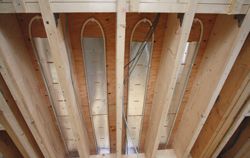As the UK strives to meet emission targets set at a reduction of 34 per cent by 2020 and 80 per cent by 2050, Adrian Troop, sales and marketing manager of Nu-Heat, suggests underfloor heating is playing a major role in the demand for greater energy efficiency.
When underfloor heating (UFH) began in the UK in the 1960s it was viewed as a luxury for upmarket homes.
More recently, of course, its many benefits have put UFH in a strong position for commercial uses as well as housing developments and social housing. These include ease of installation, freeing up valuable space by removing the need for radiators and improved heating bills.
UFH works by pumping temperature-controlled warm water from any heat source through jointless plastic tubing embedded in the floor. Unlike radiators that heat the ceiling space first, UFH provides warmth from the floor up, creating an even, radiant heat.
The standard operating temperature is 50ºC compared with 70ºC for radiators, although UFH can work at temperatures as low as 35ºC. Most floor finishes can be used.
UFH improves energy efficiency with a gas-fired boiler but when used with low carbon technology such as heat pumps, energy savings increase dramatically.
An independent report by Eu Ray (European Association of Surface Heating and Cooling) confirmed that when UFH is used with a ground source heat pump, energy costs are cut by 30 per cent. When combined with an air source heat pump, the reduction is around 20 per cent.
When a heat pump is to be integrated, insulation is crucial. Insulation levels should ideally ensure that less than 45W of heating is required per square metre of floor space.

Underfloor heating elements between joists
UFH used with a heat pump is an attractive option for developers as this will help to achieve the required levels of the Code for Sustainable Homes.
Housing association (HA) developments are at the forefront in using exhaust air heat pumps (EAHPs) with UFH. EAHPs extract air via ductwork connected to warm areas such as the bathroom and kitchen. Heat is removed from the air and transferred into the heat pump's refrigerant circuit before being discharged to the outside.
The vapour compression cycle of the heat pump raises the temperature of the refrigerant and transfers the heat to a water-based system that can either warm domestic hot water or heat the space.
The key to the efficiency of EAHP is accurate design and installation, ensuring longevity, minimum environmental impact and user satisfaction. End users, more used to conventional central heating, will need taught how to achieve the most energy efficient use of their system.
Retrofitting UFH
Nu-Heat is being asked more frequently about the practicalities of retrofitting UFH. The honest answer is that it will work efficiently in retrofit - as long as there is sufficient insulation, good design and an experienced installer.
An existing property needs to more or less meet requirements of Part L of the Building Regulations. Floor insulation is essential and may affect floor height build up. Wall and loft insulation and double-glazed windows and doors will help reach the required levels.
Suspended timber floors have little impact on floor height build-up, although ceilings or floors will have to be removed in order to lay the floor heating tube. This is fine if they are being replaced anyway but if they have to remain in situ, a floating floor is a better solution.
The floating floor is popular for retrofitting UFH as it benefits from minimal floor height build-up and is straightforward to install.
Social housing
A more recent development is the retrofitting of air source heat pumps (ASHP) and UFH in social housing. ASHPs are sited externally to extract available warmth from passing air and are the easiest heat pumps to fit as they require only to be placed against an outside wall. Single fan ASHP take up minimal space.
Retrofitting ASHP and UFH is likely to become a popular option for social housing, and is currently being included in the government-funded Technology Strategy Board's Retrofit for the Future programme, through which 87 social housing projects across the country are being retrofitted with new, innovative technologies including ASHP - with £17 million funding to help the programme succeed.
With increasing levels in the Code for Sustainable Homes, the integration of various technologies including UFH, heat pumps, solar thermal and photovoltaic will become even more essential. However, as tempting as it is, developers need to look beyond using these technologies as a quick fix and look at the longer-term issues of suitability for each project.
The flexibility of UFH, together with its longevity, suitability for use in retrofit and the ability to partner up with renewable products make it more than relevant to the coming decades.
For more information visit:
www.nu-heat.co.uk